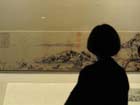| Videos | ? Latest |
|
? Feature | ? Sports | ? Your Videos |
Split painting reunited in Taipei

One of China's best ancient paintings is to be restored. After a separation of 359 years, the two pieces of "Dwelling in Fuchun Mountain," are being brought back together again. To mark the occasion, there will be an exhibition at the Taipei Palace Museum from June 1st to September 5th.
The highlight of the exhibition, the 33-centimeter-wide and 636.9-centimeter-long painting has long been deemed a masterpiece. It is the creation of the renowned painter Huang Gongwang who lived at the turn of the 14th century. Huang Gongwang was a late starter, beginning his painting career ar the age of 52. He started "Dwelling in Fuchun Mountain" aged 78, completing it three years later.
The painting depicts an idealized panorama of the Fuchun Mountains west of Hangzhou. It is commonly ranked among the 10 best ancient Chinese paintings. The painting was torn in two during the late Ming Dynasty, when a collector named Wu Hongyu tried to have it burnt shortly before he died in 1650. The two halves began to be kept in separate places two years later.
The smaller half of the 661-year-old landscape painting, often called "The Leftover Mountain Painting," has been stored in the Zhejiang Provincial Museum since 1948, when the Communist Party of China was nearing victory in the civil war against the Kuomingtang, the party that then ruled China.
The longer piece, Wu Yong Shi Volume, journeyed more dramatically and was finally taken to Taiwan after the Kuomingtang lost the civil war and is now kept in the Palace Museum in Taipei.
Premier Wen Jiabao, speaking in March last year at a news conference after the annual session of the National People's Congress, expressed his hope that the two pieces of the painting would be reunited. He also expressed a wish for rapprochement between the people living on both sides of the Straits.
With Taiwan and the mainland working together, the Taipei Palace Museum and the Zhejiang Provincial Museum signed a memorandum of understanding in January this year.
To attract more young art lovers, the Taipei Palace Museum has prepared a new media exhibit, which includes a 3D video that will be shown alongside the painting.
 0
0 







